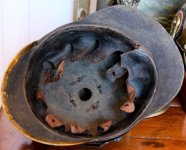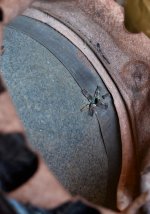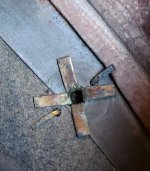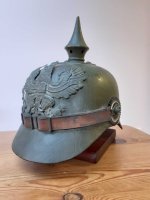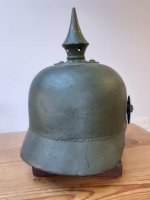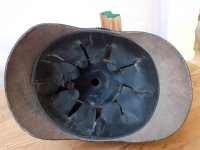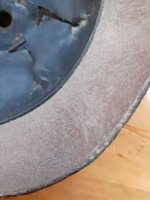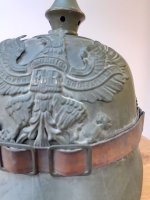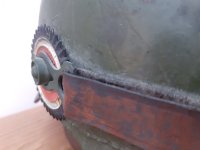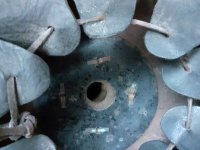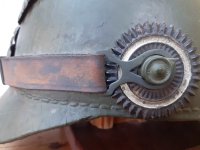You are using an out of date browser. It may not display this or other websites correctly.
You should upgrade or use an alternative browser.
You should upgrade or use an alternative browser.
An uncommon ersatz helmet
- Thread starter 911car
- Start date
Interesting. Thank you for this addition. I am still surprised that, since the felt is quite porous, the black die did not go through at all...In the magazine "Kunststoffe", volume 5 from 1915, there was something about these helmets. I don't own it, but found a snippet of it via Google. On page 107 it was written:
“Durch Matrizen werden Helm-Formen aus Filz hergestellt, die mit einer leicht und rasch trocknenden, deckenden, schwarzen Grundierpaste in Oel überzogen werden. In der Regel sind mehrere Grundierungen notwendig, da der Untergrund sehr porös ist.“ (Translated: „Felt helmets are made with matrices, which are coated with a light and quick-drying, opaque black primer in oil. As a rule, several primers are necessary because the substrate is very porous.“)
.View attachment 22739
Source: „Kunststoffe“, Volume 5 (1915), page 107 (www.google.books.de):
argonne
Well-known member
Thank you Bruno for the additional picts.
Maybe we have two kinds of treatment of felt...A thick one as on your helmet and on the saxon I showed. And as Sandy found out, a more fluid one with oil, that does not show a hard crust.
Here is another example that may illustrate Sandys documentation:
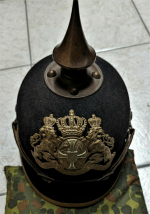
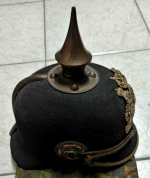
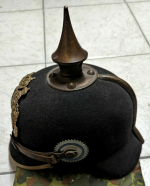
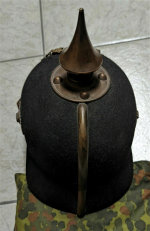
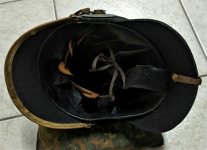
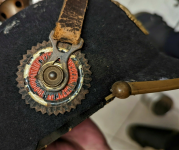
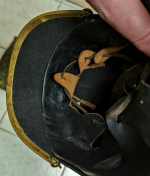
Such blackened felt Tschakos can also be seen on some period picts:

Philippe

Maybe we have two kinds of treatment of felt...A thick one as on your helmet and on the saxon I showed. And as Sandy found out, a more fluid one with oil, that does not show a hard crust.
Here is another example that may illustrate Sandys documentation:







Such blackened felt Tschakos can also be seen on some period picts:

Philippe
Thank you Bruno for the additional picts.
Maybe we have two kinds of treatment of felt...A thick one as on your helmet and on the saxon I showed. And as Sandy found out, a more fluid one with oil, that does not show a hard crust.
Here is another example that may illustrate Sandys documentation:
View attachment 22747
View attachment 22748
View attachment 22749
View attachment 22750
View attachment 22751
View attachment 22752
View attachment 22753
Such blackened felt Tschakos can also be seen on some period picts:
View attachment 22754
Philippe

This Bavarian one is much more refined! Similar to a modern bowler (melon) hat, where felt has been dyed black integrally. The one I showed looks more artisanally tarred... An emergency field treatment, as you suggested earlier?
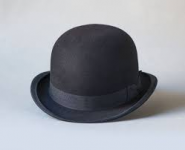
argonne
Well-known member
And another one on ebay France. The well known serial rule 
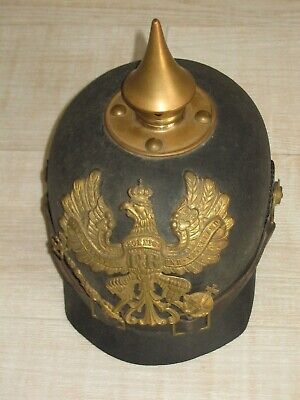
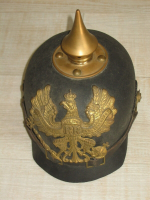
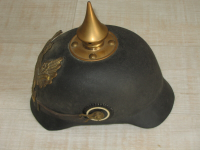
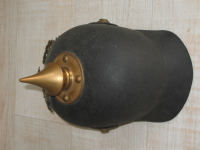


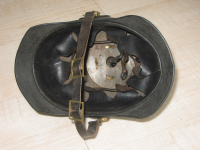
Philippe


Superbe casque à pointe allemand WW1 | eBay
Les meilleures offres pour Superbe casque à pointe allemand WW1 sont sur eBay ✓ Comparez les prix et les spécificités des produits neufs et d'occasion ✓ Pleins d'articles en livraison gratuite!
www.ebay.fr






Philippe
Sandmann
Well-known member
I fully agree with Philippe. The different surfaces of all these helmets show it also very clearly that there were different coatings.
However, the article I mentioned talks about a "covering black priming paste in oil", so I think Bruno's helmet has exactly this coating. But that doesn't contradict the bitumen coating that Philippe mentioned, because bitumen is also oil based.
At the end my reference was only meant to be a reference to an original source that someone else might have access to or that someone might want to buy, as the article seemed to contain some more detailed information about the coating.
However, the article I mentioned talks about a "covering black priming paste in oil", so I think Bruno's helmet has exactly this coating. But that doesn't contradict the bitumen coating that Philippe mentioned, because bitumen is also oil based.
At the end my reference was only meant to be a reference to an original source that someone else might have access to or that someone might want to buy, as the article seemed to contain some more detailed information about the coating.
Sandmann
Well-known member
Dear friends,
recently, I was fortunate enough to find a full 1915 issue of the "Kunststoffe" magazine I mentioned before, so I'd like to share a translation of the full article on painted replacement helmets for completeness:
Military helmets made of felt, paper pulp or metal
With the large quantity of military helmets needed for war purposes, it was necessary to refrain from making them of leather for 2 reasons. 1. because this became scarce and 2. because the production of impeccable glossy coatings is too time-consuming and therefore too costly work. Felt helmets are made by dies and then coated with an easy and quick drying opaque black primer paste in oil. As a rule, several primers are necessary because the substrate is very porous. The individual coats are sanded with pumice powder after hard drying (at approx. 60°C). The last coat is treated with a less hard abrasive, such as gur or tripel, so that it gets a weak, uniform gloss. Then the helmets are sprayed over with a black oil gloss paint or field gray oil matt paint. If no gloss at all or only a low gloss is required, the number of primer coats can be limited as far as possible, which makes the process considerably cheaper. In an analogous way, the helmets are made of brown elastic paper pulp. Before painting, they must be carefully freed from dust and sanded clean, which saves on primer material, since in the other case the paste must first level out unevenness. Since brush painting is too time-consuming and gives too uneven results, spray painting is used almost exclusively for mass production. Dip coating is also often used for military helmets. Since in both cases the substrate is sensitive to fire, only light and fast-drying oil-based paints can be considered, but their coatings must be water- and weather-resistant. Helmets made of felt or paper painted in this way should be almost as elastic or insensitive to impact as leather helmets. Attempts have also been made to produce helmets from black plate, which were painted black or field gray after priming. It remains to be seen whether these experiments can be transferred into practice.
recently, I was fortunate enough to find a full 1915 issue of the "Kunststoffe" magazine I mentioned before, so I'd like to share a translation of the full article on painted replacement helmets for completeness:
Military helmets made of felt, paper pulp or metal
With the large quantity of military helmets needed for war purposes, it was necessary to refrain from making them of leather for 2 reasons. 1. because this became scarce and 2. because the production of impeccable glossy coatings is too time-consuming and therefore too costly work. Felt helmets are made by dies and then coated with an easy and quick drying opaque black primer paste in oil. As a rule, several primers are necessary because the substrate is very porous. The individual coats are sanded with pumice powder after hard drying (at approx. 60°C). The last coat is treated with a less hard abrasive, such as gur or tripel, so that it gets a weak, uniform gloss. Then the helmets are sprayed over with a black oil gloss paint or field gray oil matt paint. If no gloss at all or only a low gloss is required, the number of primer coats can be limited as far as possible, which makes the process considerably cheaper. In an analogous way, the helmets are made of brown elastic paper pulp. Before painting, they must be carefully freed from dust and sanded clean, which saves on primer material, since in the other case the paste must first level out unevenness. Since brush painting is too time-consuming and gives too uneven results, spray painting is used almost exclusively for mass production. Dip coating is also often used for military helmets. Since in both cases the substrate is sensitive to fire, only light and fast-drying oil-based paints can be considered, but their coatings must be water- and weather-resistant. Helmets made of felt or paper painted in this way should be almost as elastic or insensitive to impact as leather helmets. Attempts have also been made to produce helmets from black plate, which were painted black or field gray after priming. It remains to be seen whether these experiments can be transferred into practice.
Last edited:
this is great information, thanks for sharing!
James
James
Last edited:
Gents,
This information is a fascinating topic and makes sense from the soldier in the field's point of view. In addition, the waterproof coating of the felt pickelhaube and Tschakos is excellent information on the flexibility of an army often characterized as a bunch of automatons. Thank you one and all for this topic and the info y'all shared.
Best regards,
John
This information is a fascinating topic and makes sense from the soldier in the field's point of view. In addition, the waterproof coating of the felt pickelhaube and Tschakos is excellent information on the flexibility of an army often characterized as a bunch of automatons. Thank you one and all for this topic and the info y'all shared.
Best regards,
John

